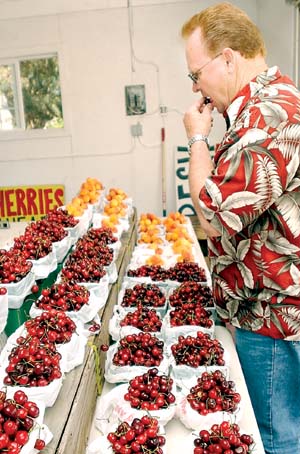
Fruit lovers may be delighted by cherries appearing a little
earlier in grocery stores and fruit stands this year, but for local
growers the situation isn’t as sweet as it sounds.
Fruit lovers may be delighted by cherries appearing a little earlier in grocery stores and fruit stands this year, but for local growers the situation isn’t as sweet as it sounds.
Recent hot weather and a warm March with little wind is wreaking havoc on cherry crops across the state, according to San Benito County Agriculture Commissioner Paul Matulich. He said the unseasonably hot spring and mild winter left local cherry growers with light crops and an early ripening.
“Some of the guys I’ve talked with only have half their crops,” Matulich said. “We’re not sure how this is going to affect the market. It could cause the price to go up because there aren’t as many, but it could also make the cost go down if the product isn’t good.”
Local growers expect cherries will be ready for harvest at least 10 days early this season. It means cherry pickers will take to the orchards in early June, during the same time Stockton and Lodi put their cherries on the market.Although it could cause the two areas to compete, University of California Cooperative Extension Farm Advisor Bill Coates said it’s better to be early than late.”The cycle right after San Benito is Washington state cherries,” he said. “It’s better to have ours coming into the stores on the tail end of north San Joaquin Valley, than be at the beginning of a new cycle.”
Without knowing how the market will end up, Coates said, this year already isn’t looking good.
Some growers may not make any money this year and others could possibly lose it.
“When you have a light crop, you still have to spend the same amount of money on watering, fertilizing and harvesting, so it’s likely some may not see any income at all,” he said. “But growers never know how much they’ve made until it’s in the bank.”
The weather not only affected the size of the crop; high temperatures forced growers to over water their trees. The result can cause cherries to have less sugar and lose their sweetness, Matulich said.
“They just don’t taste as sweet as they normally do,” said Mike Patten of San Juan Valley Produce.
Patten, who works at the stand on Highway 156, said the cherries he was selling – imports from Stockton – were not like years before.
“You can just tell that they came off the tree early,” he said. “They don’t taste as sweet and they’re not as big.”
The ideal temperatures for cherry growers are very cold winters, so the trees go dormant for a few months, and then a normal spring with light wind so the trees are nice and pollinated, cherry grower Kay Filice said.
“We’ve had a really weird year weather-wise,” she said. “The only one who can control the weather and pollination is Mother Nature.”
During cherry season, produce sections typically see cherries from the following locations, in order: south San Joaquin Valley (Tulare County), north San Joaquin Valley (Stockton, Lodi), San Jose, Morgan Hill, Gilroy, San Benito County and finally Washington State.
San Benito County cherries still have about one month left on the trees, Coates said, and a lot can happen between now and then.
“Excessive heat could be bad, but the worst thing that could happen would be rain,” he said. “This would cause the cherries to crack.”









